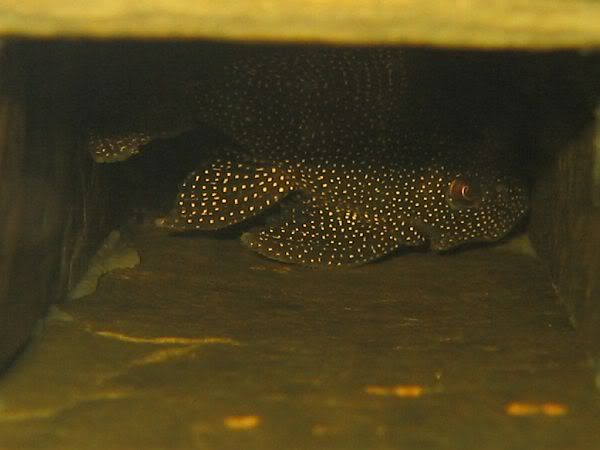Page 1 of 1
Belly coloration
Posted: 01 Oct 2005, 17:41
by Jon
Having kept both L-66, 260, and 333, I have seen quite a bit of variation on stomach coloration. I was told once that males, for the most part, carried marbled bellies, while females were clean. As a general rule, this rule seems applicable to both my L-333 and L-260, but my L-66 ALL seem to have white bellies, last I checked. However, they spawn regularly. I do recall one of my L-66 specimens having some minor reticulation on his belly, but it disappeared--how can that be? I haven't recently glanced at my dominant male, but my subdominant has a cleanm white stomach-he's fathered at least one brood, so he's a male for sure, and IIRC, the dominant specimen has quite a nice white rump also. So is belly coloration devoid from that particular species or do I just house a couple of genetic exceptions?
Posted: 03 Oct 2005, 17:23
by bronzefry
Great question, Jon. Can you please add L-147 to the mix? It's not a great picture of the belly, but it's quite different from the rest of the pattern:

He's not very photogenic. I'll try to get a better pic.
Amanda
Posted: 09 Oct 2005, 21:58
by racoll
I've got an L333 that i'm very sure is female. next time she goes up the glass, i'll let you know, and try and get a few pics.
My male L262 has a slightly marbled belly:

My other one (which i'm hoping will be a female) has a much cleaner belly.
I'll try to get some pics of her too.
I'll be buying a few more, and i'll use this character to help me decide!
Posted: 10 Oct 2005, 16:19
by drpleco
I was just about to ask the same question about my bristlenoses. I have 2 females with spotted bellies, two males with a few spots, and one female with a clean, white belly. From the top, they all look identical. Is this normal variation or am I working with different species? This is my breeding group so I'd like to avoid hybridization.
I know that a. claro have white bellies, but I'm pretty sure that my female isn't one.
any ideas?
Posted: 10 Oct 2005, 18:08
by racoll
I don't know about BN's but i'm sure someone will.
Here is a shot of the three L262 i got today to bring my number up to five.
The big one is clearly a male, and it has a very similar belly to my other male above.

This should make the other two females

I hope!
Posted: 11 Oct 2005, 00:04
by Jon
I couldn't help but notice that one of your L-262 has very fine spots. I have a similar predicament in which, of my trio, which were supposedly caught from the same vicinity, one has the same fine spots as the female in the center. Is this merely a coloration difference or a separate species altogether?
Posted: 11 Oct 2005, 10:52
by Yann
Hi!
until the species is described and the distribution is given, I would treat these as seperated species...
You have at least a pair!
Cheers
Yann
Posted: 11 Oct 2005, 21:26
by racoll
I would treat these as seperated species...
Interesting. I thought the usual practice would be to lump them, especially if they have a limited distribution and the same catch locality (which i presume is the same). They were on the same list as L260 (Tapajos) and were flown out of Recife.
I've seen a few of these "micro-spot" L262 before. Second fish down in this post:
http://www.planetcatfish.com/forum/view ... light=l262
They do appear quite dfferent though. I'll try and get some more shots when they have settled down.
Have you got any photos of yours Jon?
Posted: 12 Oct 2005, 16:25
by Jon

as opposed to:

from the pics it doesn't seem readily visible, but believe me, there's a big difference. I can get the small spotted indivdual out of his cave for the life of me, though.
Posted: 14 Oct 2005, 14:19
by bronzefry
I was curious about belly patterns in general. What their function is, etc.




